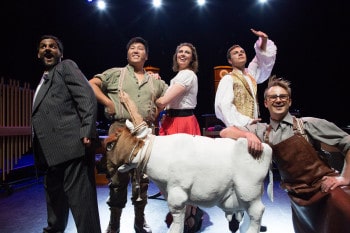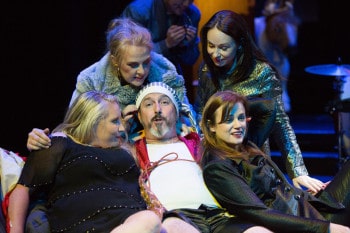Lyric Opera of Melbourne: L’heure espagnole & Gianni Schicchi
For months, Lyric Opera of Melbourne milked everything possible in their advertising campaign that, at first seemingly cryptic, flooded their Twitter feed with the hashtag #MeetTheMule. It was a clever association (accompanied with beaut marketing) to two delightful and comic stories set to one-act operas that premiered in the early years of the 20th century: Puccini’s Gianni Schicchi (1918) and Ravel’s L’heure espagnole (1911).

In L’heure espagnole the mule driver Ramiro arrives at the clockmaker Torquemada’s shop for a watch repair but Torquemada needs to attend to his weekly errand of regulating the town’s clock. Ramiro is asked to wait, during which time, at the request of the clockmaker’s wife Concepción, he unquestioningly shifts a couple of grandfather clocks (concealing male goods) up and down unseen stairs. Concepción uses Torquemada’s weekly absence to ‘entertain’ male companions but gradually warms to the hulking Ramiro as the man to satisfy her sexual appetite for which Ramiro warms to.
In Giannni Schicchi the death of the wealthy landowner Buoso Donati causes pandemonium amongst his relations on learning that he left his mansion and prized mule to monks. Gianni Schicchi is brought in to assist. Disguising himself as a ‘revived’ Buoso, Schicchi dictates a new will to a notary in front of the family, double-crossing them to secure the mansion and mule for himself and at the same time a healthy dowry for his daughter who is in love with Rinuccio, the youngest Donati.
For its purpose, a new role awaited the roll-about half-sized cow Milky White (from Victorian Opera’s 2013 production of Into the woods), who comes cleverly disguised as a mule.
It introduces a fun element to the performance when no part exists for a mule in either work. With it, this time co-directed by Nicholas Cannon and Jane Millet, Lyric Opera of Melbourne presented a visually creative, nifty staging. But with so much attention given to the mule, at times the all-important fine-tuned direction of the actual cast seemed forgotten.
Surrounding conductor Pat Miller and his six-piece orchestra, a U-shaped, stepped cat-walk platform established the comings and goings of racetrack-like action while much of the drama rested and comically wove through the orchestra space. Two quaintly stylised grandfather clocks feature amongst a sprinkling of other apt furnishings, including a table for the clockmaker in L’heure espagnole and a chaise lounge as Buoso’s deathbed in Gianni Schicchi. The big picture was perfectly satisfied but despite an energetic cast the comedy filtered through in drips.
The lesser-known L’heure espagnole suffered drag soon after a promisingly staged introduction to its commedia dell’arte-inspired characters, complicated by patchy diction and an abrasive English translation. It disappointingly didn’t meet expectations despite all fine intentions. Then again, the work received just nine performances at its premiere and wasn’t staged again for years. I couldn’t help but think seeing Franc-Nohain’s stage play or comédie-bouffe (which Ravel based his opera on to a libretto also by its author) might have made for a more rewarding experience.
After interval, the oft-performed Gianni Schicchi was set in late 1970s Australia going by unaffected accents and slick costumes, and pumped much needed drama and comedy into the night. Drawing an audience member to stand in lying down as the dead Buoso Donati, the interactive style continued with a search amongst the audience for the missing will. The large cast of 13 soloists provided many more comically delivered moments, including the animated anxiousness during the reading of the will and the cheekily acted trio of Donati women who pressure Schicchi to assist in the family’s deception.
But on opening night musical and vocal sharpness didn’t reach the mark achieved in recent productions. The confidence that appeared in the acting, sometimes overly, not often enough came through in the singing. There were, however, some consistently attractive performances that harnessed praise across the night.

Appearing as the straightforward-thinking Ramiro in L’heure espagnole, baritone Raphael Wong, sporting a recent Green Room Award nomination, again showed warmth and sturdiness in voice together with believability of character.
As another more rugged and distilled baritone James Payne made a playfully cunning Gianni Schicchi. Drawing worthy applause and halting family shenanigans, soprano Rebecca Rashleigh, as Schicchi’s daughter Lauretta, sung with crystal clarity and sweetly phrased beauty in the night’s notable aria “O mio babbino caro”, certainly a voice with a bright future.
Nigel Huckle’s appeal as the dandyish poet Gonzalve in L’heure espagnole came courtesy of a smooth, resonant musical theatre-like tenor and Daniel Sinfield, as the spectacled but unseeing clockmaker Torquemada and as Gherado in Gianni Schicchi, impressed with a wholehearted investment in his characters and a strong, broad tenor.
After fine musical results in 2014 with a larger orchestra, it seemed a backward step employing just a six-piece orchestra without the padded warmth of strings. Both Ravel’s and Puccini’s score was exposed with threadbare vulnerability to mixed results.
When the fun is over, Lyric Opera of Melbourne venture back into more serious territory again, highlighting their continual progressive approach to presenting opera in the small with a production of the first opera composed and set in Melbourne. Stella, by George William Louis Marshall-Hall, completed in 1910 and not seen or barely heard of since 1912 is a work highly anticipated and the high standards matching such productions as Werther (2014) and Iphigénie en Tauride (2013) are hoped for.


